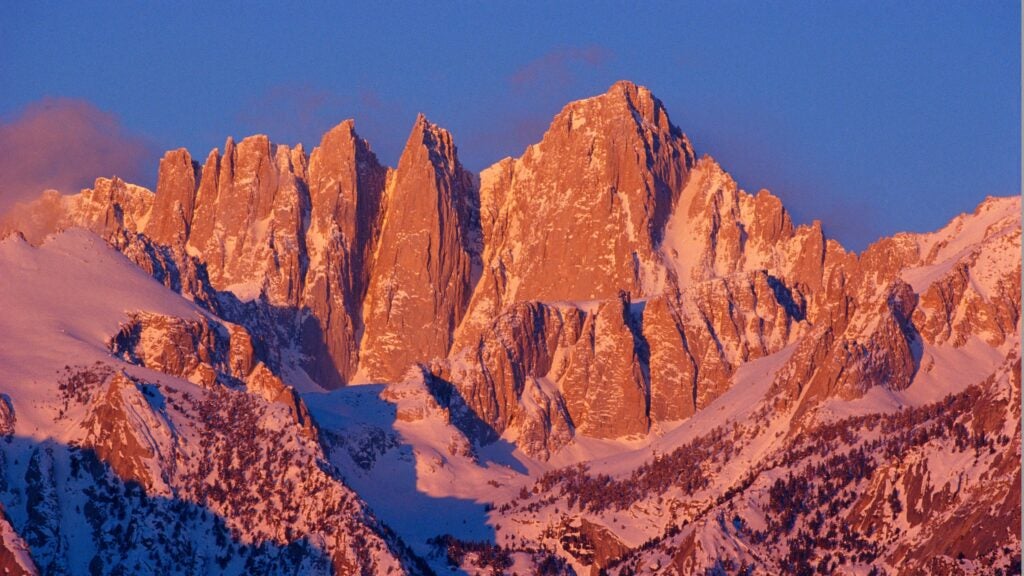At the Whitney portal trailhead—the main starting point for both dayhikers and backpackers on the Mount Whitney Trail—there’s a scale to weigh your backpack. This September, before I started my trek, I slipped off my pack and hung it on the scale. For my 22-mile dayhike, I had packed 3 liters of water, breakfast, lunch, some snacks, hand warmers, gloves, a puffy, a solar-powered phone charger, my first-aid kit, a water filter, and a couple more extraneous pieces of gear. My total pack weight for a day on the trail tipped the scale at 19 pounds, which wouldn’t earn me the respect of any ultralighter.
So when I read online that last weekend Inyo Search and Rescue had to rescue a pair of Mount Whitney hikers—who between them had “150 lbs of newly purchased gear plus 5 gallons of water”—my jaw hit the floor. Five gallons of water weighs just under 42 pounds; in total, that meant that each of these hikers was toting roughly 96 pounds—or five times my not-so-light pack weight. The strongest hikers would seriously struggle to carry this gear. How could these hikers manage?
Unsurprisingly, they didn’t make it very far. The pair started their trek at 6 P.M. Friday, November 1, with a plan to camp at Lone Pine Lake and tag the summit on Saturday. They hiked 2.7 miles until they became too exhausted and stopped around 3 a.m. By then, one hiker had two blisters and a bad headache, so they set up camp on the trail. One of the hikers also told Inyo SAR she had a mass in her brain that was sensitive to barometric pressure. Later, the pair woke up to snow showers that had filled their shoes.
Luckily, the pair recognized they had reached their limit and called for help via their iPhone’s SOS setting. By 10 A.M. Saturday, the search and rescue team was on the move, reaching them by 1:40 P.M. and escorting them down the mountain to reach the trailhead by 3:15 P.M.
It’s clear that this pair was new to the trails: They had to buy all the gear for this hike, and the sheer amount they brought would give the strongest hikers pause. Among their 150 pounds of gear, they didn’t bring a map, a bear canister, or a water filter. The last item would have been especially helpful: On the Mount Whitney Trail, there are lots of lakes and reliable sources, which means that carrying more than a couple of liters at a time is generally overkill.
Being the tallest mountain in the lower 48, Mount Whitney is a dream peak for all types of hikers. However, it’s a serious undertaking that requires lots of research and training. In their Instagram post about this rescue, Inyo SAR recommends that hikers without proper gear or experience hire a guide service. So we reached out to Ryan Huetter, an IFMGA/AMGA Certified Mountain Guide who works for Sierra Mountain Guides in Bishop, California, to get his perspective on this incident. He has guided anyone from “complete novices to seasoned experts” on expeditions all around the Sierra and the world.
“For a lot of inexperienced people who may not even have previous backpacking experience, let alone experience at altitude, or in inclement weather, [the Mount Whitney Trail] may be incomprehensibly hard for them,” he says. Sure, an inexperienced hiker might be able to blaze up and down the mountain without a problem in perfect weather, but “in early season, late season, or winter conditions, it is not a place to learn those skills,” he says.
In many cases, having a guide would help stop preventable disasters on the mountain, like bringing 150 pounds of gear and five gallons of water. Guides can perform gear checks to help remove unnecessary gear from your pack. Depending on the company and the specific expedition, guides can also sometimes provide gear if the hikers don’t already have it. When it comes to gear mishaps, Huetter, however, has seen it all.
“I’ve watched people duct tape a 30 pack of little water bottles to the outside of their packs,” he says. “I’ve also seen the same but with a case of beer.” In the Sierra, he recommends carrying two liters of water and packing a BeFree, a Sawyer Squeeze or some other easy filter.
Mount Whitney’s height and beauty attracts hikers of a wide range of experience from all around the world. Seeing hikers breaking Leave No Trace rules or acting erratically is not uncommon. Although hiring a guide or doing more research would have saved the hikers from last weekend’s incident a lot of trouble, they did a few things right. They stopped to rest when they were exhausted instead of pushing forward. Instead of splitting up, they stayed together. They called for help when conditions deteriorated, and when SAR came, they listened to instructions and descended.
The morals of this story? Don’t pack too much weight, and make sure essential gear makes it into your pack; make sure you’re physically prepared before tackling a challenging hike; check the weather forecast and be ready for bad conditions when hiking the mountains in late and early season. Most of all, remember that having SAR access is a life-saving privilege that relies on community donations and, sometimes, volunteer labor. Consider reaching out to your local SAR team, donating, or even joining.


